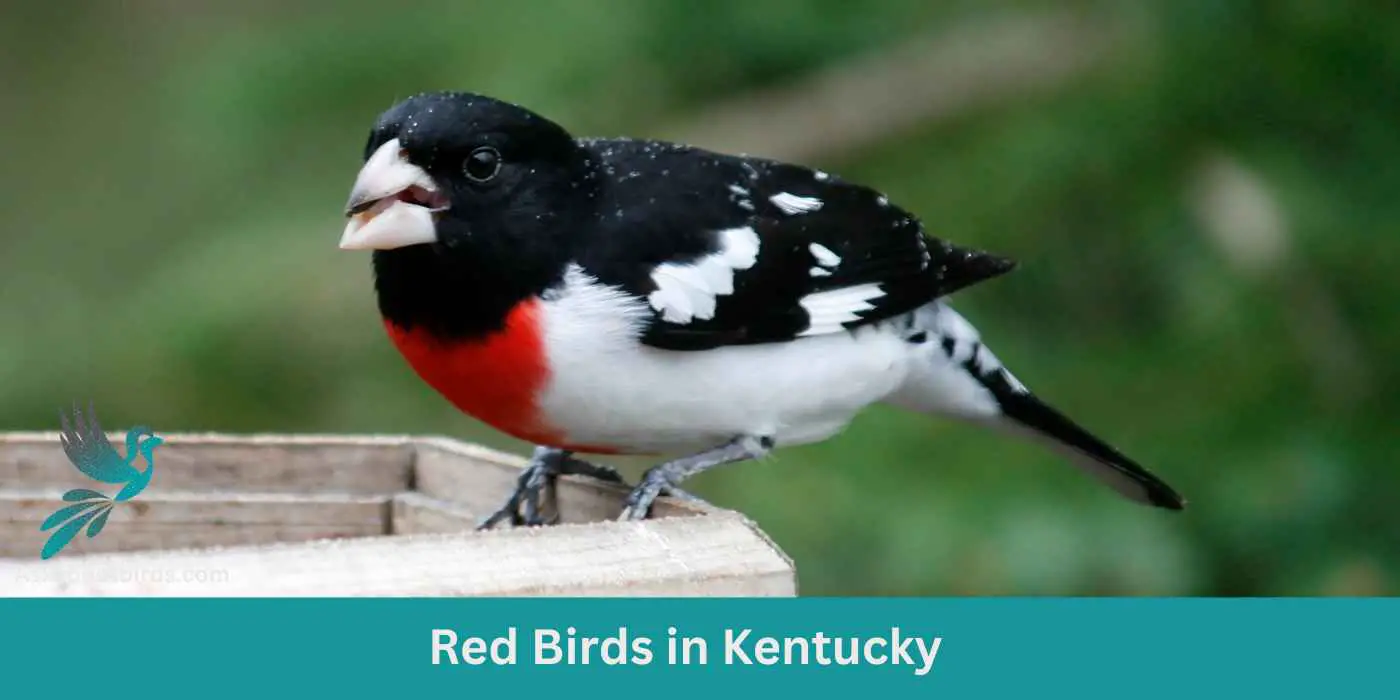Kentucky, with its lush landscapes and diverse habitats, is home to a plethora of bird species, but its red birds are truly a sight to behold.
The state’s numerous waterways, forests, and open spaces provide essential nesting and feeding grounds, attracting both resident birds and migratory species, contributing to its rich avian diversity.
Discover 12 of the most mesmerizing red birds that grace the skies and woodlands of the Bluegrass State.
Red Birds Found In Kentucky
Kentucky’s geographical positioning, combined with its varied landscapes—from the Appalachian Mountains in the east to the Mississippi River in the west—creates a unique blend of habitats. These diverse environments, rich in both flora and fauna, make it a haven for a wide range of bird species.
Northern Cardinal


| Feature | Measurement |
|---|---|
| Scientific Name | Cardinalis cardinalis |
| Length | 8.3 – 9.1 in |
| Wingspan | 9.8 – 12.2 in |
| Weight | 1.19 – 2.29 oz |
The Northern Cardinal is an iconic North American bird, easily recognized by its vibrant color and melodious song.
Appearance: Male Northern Cardinals are a brilliant scarlet red, while females display a more subdued reddish olive. Both sexes have a distinctive black ‘mask’ on their face around the bill and a pointed crest on their head. The bird’s beak is robust, cone-shaped, and bright orange in color.
Diet: Northern Cardinals are primarily granivorous, with a diet largely consisting of seeds and grains. They also eat fruits and insects. These birds typically feed off the ground and are frequent visitors to bird feeders.
Reproduction: Northern Cardinals are monogamous, and a pair will breed together for life. The female typically builds a well-hidden nest in a dense thicket or shrub. She lays 2-5 eggs per clutch, which she incubates for around two weeks.
Summer Tanager


| Feature | Measurement |
|---|---|
| Scientific Name | Piranga rubra |
| Length | 6.7 in |
| Wingspan | 28 to 30 cm |
| Weight | 29 g |
The Summer Tanager is a medium-sized songbird admired for its radiant plumage and melodious song.
Appearance: Male Summer Tanagers are an impressive bright red, while females and juveniles present a softer, yellow-orange color. Both genders have a large, slightly hooked bill and relatively short tail.
Diet: Summer Tanagers primarily feed on insects, including bees and wasps, which they catch in flight or pick off vegetation. They are also known to eat fruits and berries, making them helpful in controlling pest populations and seed dispersal.
Reproduction: The female Summer Tanager builds a loose, shallow cup-shaped nest out of twigs and grass, usually hidden in the foliage of trees. The female typically lays 3-5 eggs, which she will incubate for about two weeks.
Scarlet Tanager


| Feature | Measurement |
|---|---|
| Scientific Name | Piranga olivacea |
| Length | 6.3 to 7.5 in |
| Wingspan | 9.8 to 11.8 in |
| Weight | 23.5 to 38 g |
The Scarlet Tanager is a strikingly colorful bird known for its brilliant plumage and distinctive song.
Appearance: Male Scarlet Tanagers are notable for their vibrant scarlet bodies contrasted with black wings and tail, making them one of the most intensely colored birds. Females and juveniles, on the other hand, have a subdued olive-yellow body color with darker wings and tail.
Diet: The diet of the Scarlet Tanager is largely made up of insects, including beetles, cicadas, aphids, and others. They are adept flycatchers, seizing insects in mid-air or picking them off foliage. They also consume fruits and berries, especially during migration and in their winter habitats.
Reproduction: The female Scarlet Tanager builds a cup-shaped nest using twigs, rootlets, and grass, typically well-hidden in the dense foliage of trees. She lays 3 to 5 eggs and incubates them for about two weeks.
Red-Winged Blackbird
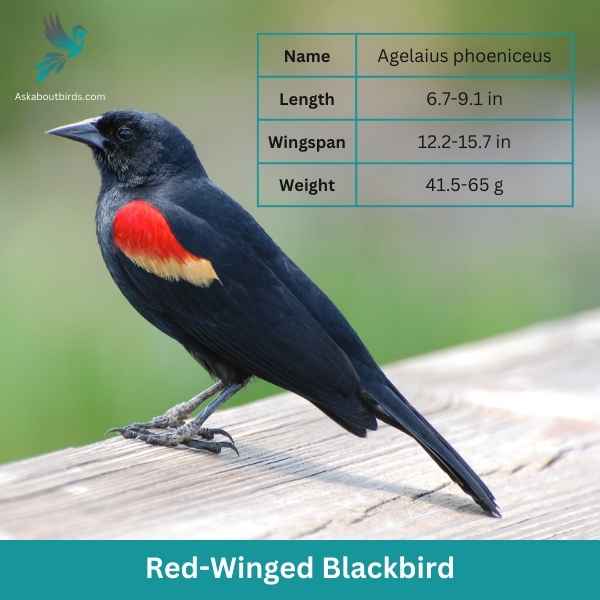
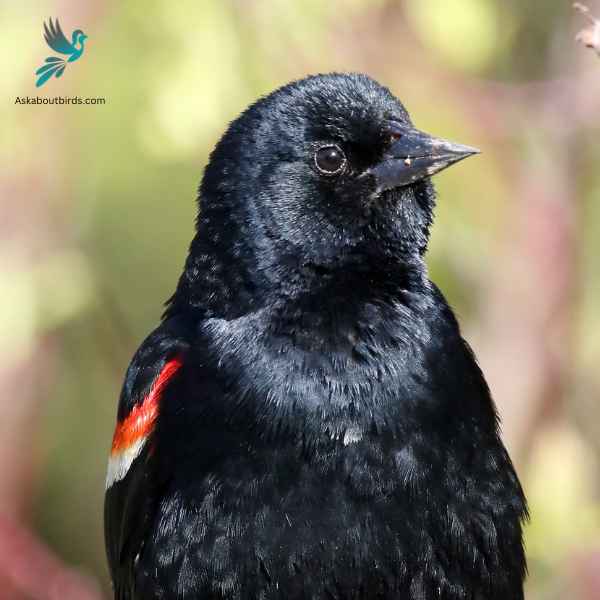
| Feature | Measurement |
|---|---|
| Scientific Name | Agelaius phoeniceus |
| Length | 6.7-9.1 in |
| Wingspan | 12.2-15.7 in |
| Weight | 41.5-65 g |
The Red-Winged Blackbird is a familiar sight across North America, especially in wetlands and open areas. Known for its striking coloration and distinct call, it is often seen perched on cattails or utility lines.
Appearance: Male Red-Winged Blackbirds are glossy black with bright red-and-yellow shoulder patches, while females are streaky brown, resembling a large sparrow. The males’ red patches become more prominent when they’re displaying or agitated.
Diet: Red-Winged Blackbirds primarily feed on seeds and insects. Their diet includes grains, sunflower seeds, and corn, but they also eat beetles, caterpillars, and other small invertebrates, especially in the breeding season.
Reproduction: Red-Winged Blackbirds nest in marshes, along watercourses, and in wet fields. The female constructs a cup-shaped nest using grass and sedge, attaching it to plants above water. She typically lays a clutch of 3 to 4 blue-green eggs, which she incubates for about 11-12 days. Males, being polygynous, often have multiple mates during a single breeding season.
Red-headed Woodpecker

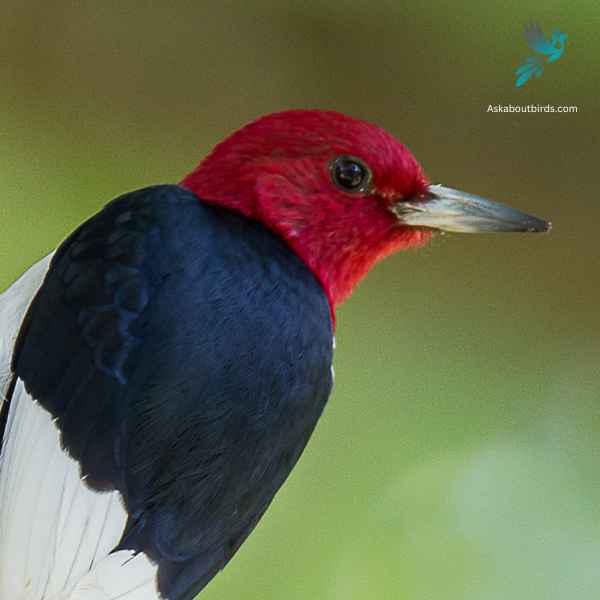
| Feature | Measurement |
|---|---|
| Scientific Name | Melanerpes erythrocephalus |
| Length | 7.5–9.1 in |
| Wingspan | 16.5 in |
| Weight | 2.0–3.2 oz |
The Red-headed Woodpecker is a striking forest bird with a bold tri-colored pattern.
Appearance: This woodpecker features a completely red head and neck, contrasting starkly with its white underparts and black wings. Its wings also have large white patches which are conspicuous in flight.
Diet: Red-headed Woodpeckers have a varied diet including insects, seeds, fruits, berries, and occasionally even the eggs of other birds. They’re also known to store food by wedging it into crevices in bark.
Reproduction: These woodpeckers nest in cavities which they excavate in dead wood or dead parts of live trees. These cavities can be found anywhere from 2 to 80 feet off the ground.
Eastern Towhee

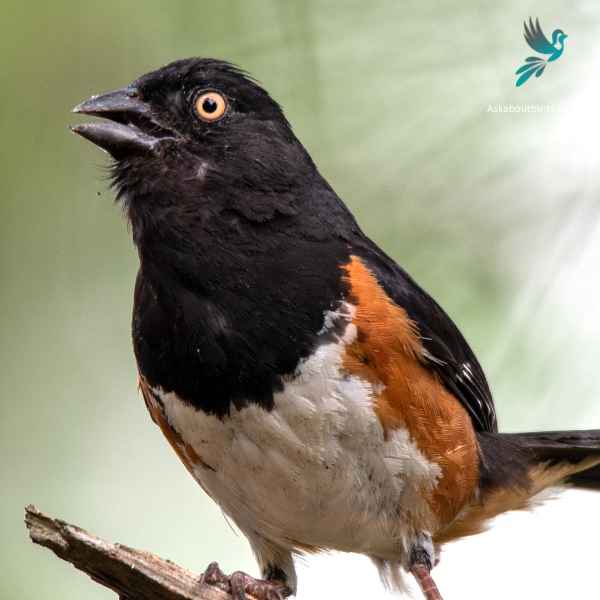
| Feature | Measurement |
|---|---|
| Scientific Name | Pipilo erythrophthalmus |
| Length | 6.8 to 9.1 in |
| Wingspan | 7.9–11.8 in |
| Weight | 32 to 53 g |
The Eastern Towhee is a distinctive songbird known for its unique calls and eye-catching coloration.
Appearance: Male Eastern Towhees are characterized by a striking combination of a black head, back and tail, contrasting with a white belly and rufous flanks. Females sport similar patterns but instead of black, they have a rich brown color. Both genders have red eyes, lending a special charm to their overall appearance.
Diet: Eastern Towhees primarily feed on a variety of insects, seeds, and berries. Their diet is quite diverse, taking advantage of seasonal offerings, which includes beetles, caterpillars, spiders, acorns, grass seeds, and various fruits and berries.
Reproduction: Eastern Towhees build their nests on or near the ground, often in a shrub or a small tree. The female lays around 3-5 eggs and takes the primary role in incubating them over about 12-13 days.
House Finch


| Feature | Measurement |
|---|---|
| Scientific Name | Haemorhous mexicanus |
| Length | 5–6 in |
| Wingspan | 8–10 in |
| Weight | 0.6–0.9 oz |
The House Finch is a small songbird widely distributed across North America and is commonly found in urban and suburban areas.
Appearance: Males of this species are brightly colored with crimson faces and throats, which can extend to the chest and back, while their flanks have streaks. The female is streaked brown and lacks the red coloring. Both have a square-tipped tail and a distinctively long, flat-topped bill.
Diet: House Finches primarily eat seeds, grains, and berries. They have a particular fondness for sunflower seeds and can be commonly seen at bird feeders. Occasionally, they will also consume insects, especially during the breeding season.
Reproduction: House Finches are cavity-nesters and might choose ledges, vents, ledges, and other urban settings. They might also utilize trees or shrubs. Their nests can be made of a wide array of materials, from feathers to twigs.
American Robins


| Feature | Measurement |
|---|---|
| Scientific Name | Leptotila plumbeicep |
| Length | 10.6-11.8 in |
| Wingspan | — |
| Weight | 160-200 g |
The American Robin is a widely recognized bird species known for its melodious song and early bird tendencies.
Appearance: American Robins are medium-sized birds with a distinctive appearance. Both males and females sport a gray to brown back and a warm red to orange breast and belly and gray wings. They also have a characteristic white eye-ring and a black head, but males are usually darker than females.
Diet: American Robins have a diverse diet that changes depending on the season. In summer, they feed heavily on earthworms, beetles, and other invertebrates, which they catch on the ground. During winter, they mostly eat fruits and berries.
Reproduction: American Robins usually build their nests in trees or shrubs, but they are also known to nest on human-made structures. The female lays a clutch of about 3 to 5 eggs, which she incubates for about 12 to 14 days.
Red-bellied Woodpecker
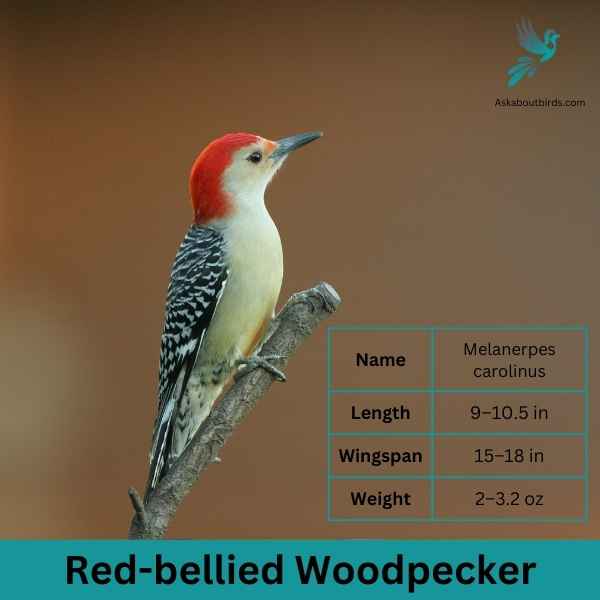
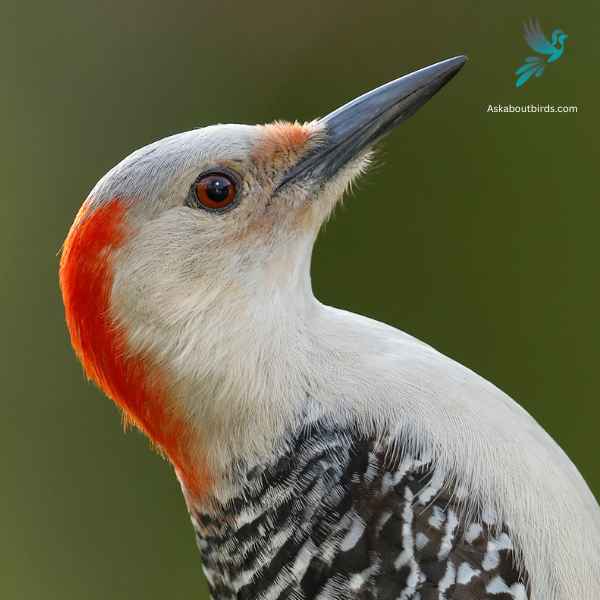
| Feature | Measurement |
|---|---|
| Scientific Name | Thryothorus ludovicianus |
| Length | 4.7–5.5 in |
| Wingspan | 11 in |
| Weight | 0.63–0.81 oz |
The Red-bellied Woodpecker is a medium-sized woodpecker commonly found in woodlands, forests, and backyards across the eastern and central U.S.
Appearance: The Red-bellied Woodpecker sports a pale gray face, throat, and belly, contrasted by a zebra-striped back. Its name derives from the subtle reddish tinge on its belly, but it’s more commonly recognized by the vivid red cap on the head of males and the partial red cap on females.
Diet: This woodpecker has a varied diet that includes insects, fruits, nuts, and seeds. They frequently forage on tree trunks and branches, using their sticky, barbed-tipped tongue to extract ants, beetles, and other insects from crevices.
Reproduction: Red-bellied Woodpeckers are cavity nesters, excavating holes in tree trunks for their nests. The inside of the nest is typically unlined or sparingly lined with wood chips.
Rose-breasted Grosbeak
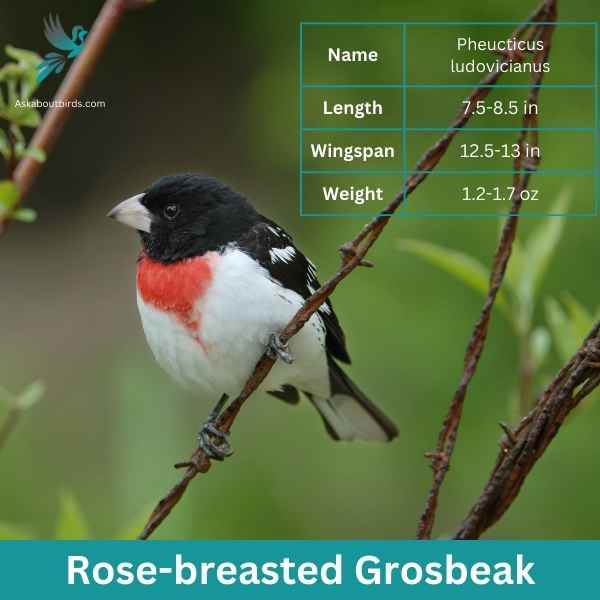

| Feature | Measurement |
|---|---|
| Scientific Name | Pheucticus ludovicianus |
| Length | 7.5-8.5 in |
| Wingspan | 12.5-13 in |
| Weight | 1.2-1.7 oz |
The Rose-breasted Grosbeak is a songbird of medium size, widely recognized for its vibrant coloration and melodious song.
Appearance: Male Rose-breasted Grosbeaks boast a striking contrast with black and white plumage accompanied by a radiant rose-colored patch on the chest and under the wings. In contrast, females exhibit streaked brown and white plumage, resembling large sparrows but with a thick bill.
Diet: The diet of the Rose-breasted Grosbeak consists of a mixture of seeds, insects, and fruits. During summer, they primarily feed on insects, while seeds and fruits become more prevalent in their diet during the colder months.
Reproduction: These birds build cup-shaped nests typically situated in trees or large shrubs. Both the male and female partake in incubation duties, ensuring the eggs’ safety and warmth. After hatching, the chicks are primarily fed insects.
Pine Grosbeak

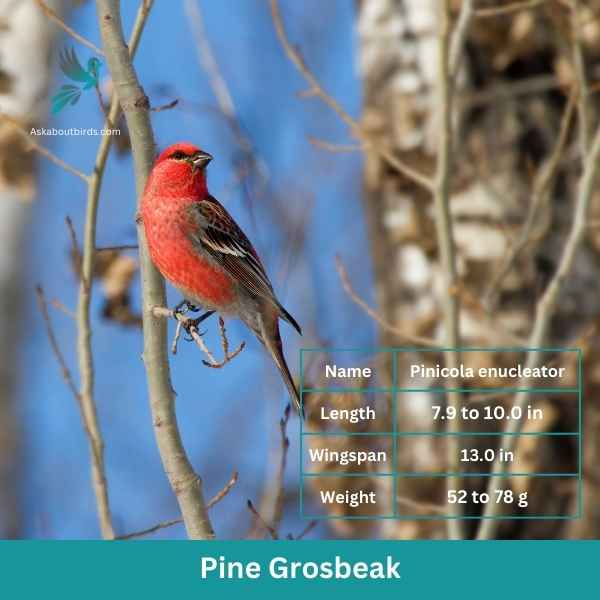
| Feature | Measurement |
|---|---|
| Scientific Name | Pinicola enucleator |
| Length | 7.9 to 10.0 in |
| Wingspan | 13.0 in |
| Weight | 52 to 78 g |
The Pine Grosbeak is a striking bird native to the northern regions of North America, often found in coniferous forests. Both males and females have a plump and robust body with a large beak adapted for eating seeds. The male Pine Grosbeak displays a vibrant reddish-pink plumage, while the female has a more subdued grayish-brown coloration.
These birds are typically seen in small flocks, foraging for food in trees and on the ground. They have a preference for seeds, particularly those from various conifer species. The Pine Grosbeak uses its strong bill to crack open the cones of tall trees and extract the seeds, but they also consume berries and small fruits when available.
Red Crossbill
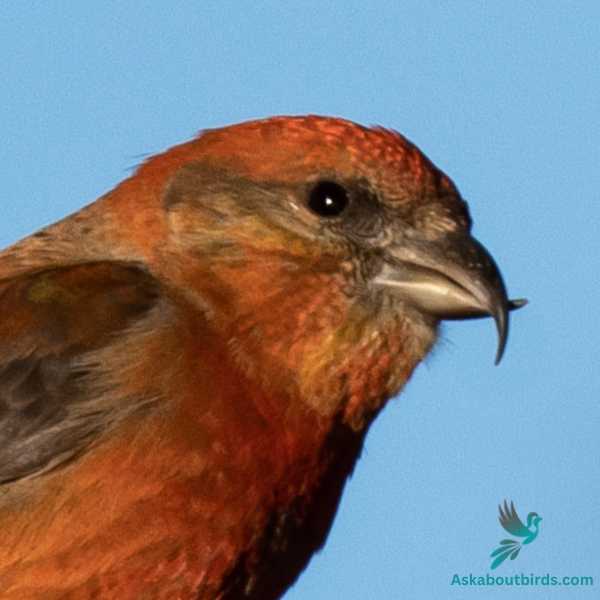

| Feature | Measurement |
|---|---|
| Scientific Name | Loxia curvirostra |
| Length | 20 cm |
| Wingspan | 27–29 cm |
| Weight | 40-53 g |
The Red Crossbill is a peculiar bird species, celebrated for its unique beak structure and vibrant coloration.
Appearance: Red Crossbills are named for their distinctive crossed mandibles, which are adapted to extracting seeds from conifer cones. Male Red Crossbills are usually bright red or orange, while females and juveniles are greenish-yellow. All have dark wings and notched tails.
Diet: The diet of the Red Crossbill is primarily composed of conifer seeds, their unique beak allowing them to access these seeds with ease. This diet includes seeds from pine, spruce, and other types of coniferous trees. They are also known to consume some insects.
Reproduction: Red Crossbills are known for their flexible breeding season, which can occur any time of the year when there is an abundance of food. They typically nest in conifers, where the female lays a clutch of 3 to 4 eggs.
Where to Spot Kentucky’s Red Birds
Kentucky, with its picturesque landscapes and rich avian habitats, offers some of the most compelling spots for birdwatchers, especially those keen on spotting vibrant red birds.
- Mammoth Cave National Park: An expansive cave system amidst hardwood forests, this park is a prime location for spotting various bird species, including the scarlet tanager and the northern cardinal.
- Land Between the Lakes National Recreation Area: Spanning between Kentucky Lake and Lake Barkley, this area provides diverse habitats attracting a range of bird species, especially during migration seasons.
- Red River Gorge: Located within the Daniel Boone National Forest, this gorge is not only known for its scenic beauty but also as a hotspot for birdwatching, including several species of woodpeckers and tanagers.
- Bernheim Arboretum and Research Forest: An oasis of green, this location is frequented by various bird species throughout the year, with well-maintained trails offering excellent birdwatching opportunities.
- Sloughs Wildlife Management Area: Situated in the northwest corner of the state, it provides crucial wetland habitats, attracting a variety of waterfowl and songbirds, making it a must-visit for bird enthusiasts.
| State’s Red birds | Top Birdwatching Spots |
|---|---|
| Illinois’s Red birds | 1. Starved Rock State Park 2. Cache River Wetlands 3. Montrose Point Bird Sanctuary |
| Indiana’s Red birds | 1. Goose Pond Fish and Wildlife Area 2. Eagle Creek Park 3. Indiana Dunes National Park |
| Missouri’s Red birds | 1. Mingo National Wildlife Refuge 2. Forest Park, St. Louis 3. Mark Twain National Forest |
| Ohio’s Red birds | 1. Magee Marsh Wildlife Area 2. Cuyahoga Valley National Park 3. Shawnee State Forest |
| Tennessee’s Red birds | 1. Great Smoky Mountains National Park 2. Radnor Lake State Park 3. Reelfoot Lake State Park |
| Virginia’s Red birds | 1. Shenandoah National Park 2. Chincoteague National Wildlife Refuge 3. Great Dismal Swamp National Wildlife Refuge |
| West Virginia’s Red birds | 1. New River Gorge National Park and Preserve 2. Canaan Valley 3. Monongahela National Forest |
FAQs on Red Bird Species Found in Kentucky
Which red birds with bright yellow throats are frequently spotted in Kentucky’s forests?
The Summer Tanager males, known for their vibrant red plumage complemented by bright yellow throats, are commonly seen in the forest canopy and edges of Kentucky. These medium-sized birds often forage in the leaf litter or catch flying insects, making them fascinating to watch for bird enthusiasts.
What kind of bird, with bright red plumage and two white wing bars, is a common visitor to backyard feeders in Kentucky?
The Purple Finch, particularly the males, boasts a bright red plumage contrasted with two white wing bars. These stunning birds are attracted to black oil sunflower seeds and are frequent visitors to backyard feeders in Kentucky. Their striking appearance makes them easily distinguishable from other bird species.
What are the distinguishing features of the white-winged crossbill?
The white-winged crossbill is a unique bird known for its specialized beak adapted to extract seeds from conifer cones. Its standout features include a bright color palette, often contrasting yellow birds with its own striking appearance. Most notably, as the name suggests, it sports prominent white markings on its wings, which set it apart from other birds in its habitat.
What is the habitat preference of the ruby-throated hummingbird?
The ruby-throated hummingbird, a medium-sized bird, predominantly favors forest edges and shade trees as their primary habitat. These nimble wild birds are often seen flitting around bird feeders, especially those filled with sugary nectar. Their presence adds a dynamic vibrancy to their surroundings, often complemented by their rapid wing movements and agile aerial maneuvers.

